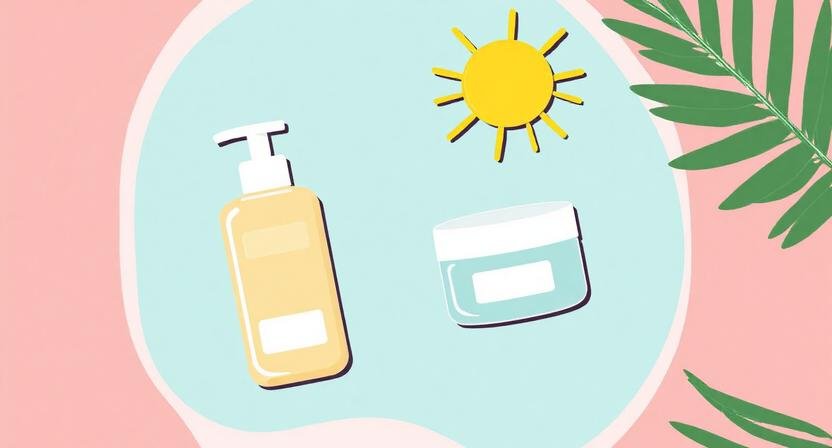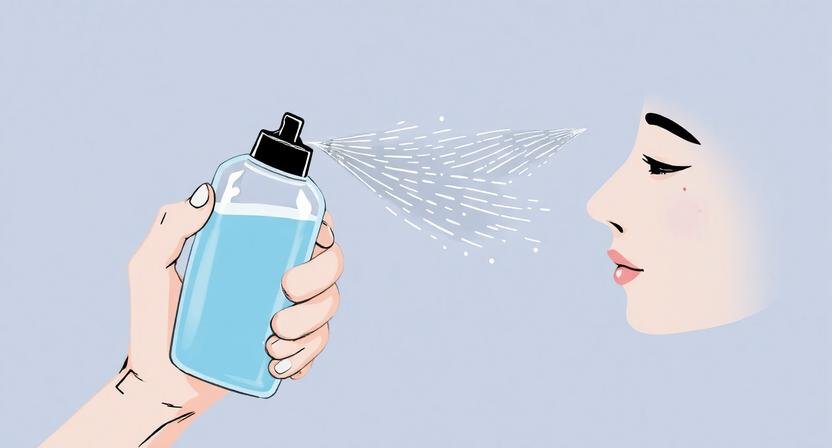How to Build a Routine for Acne-Prone Skin

Let’s be honest, “acne-prone” is less a skin type and more a personality trait at this point. You look at a new product and your face is like, absolutely not. The good news is you do not need a 10-step routine to calm things down. What you need is a simple, repeatable plan that keeps pores clear, barrier happy, and breakouts from turning into a long-term situation.
We’ll walk through how to build a routine from scratch for acne-prone skin, step by step, with room to plug in your favorite products later.
Step 1: Understand What “Acne-Prone” Really Means
Acne happens when pores get clogged with dead skin cells and sebum, then bacteria and inflammation join the party. Acne-prone skin just does this more easily and more often.
Common features:
Oilier T-zone or all-over shine
Clogged pores (blackheads, whiteheads)
Red bumps and pus-filled spots (papules and pustules)
Sometimes deeper, painful cysts
Genetics, hormones, stress, some medications and comedogenic products can all play a role. You cannot rewrite your genes, but you can make your pores a lot less inviting to clogs and calm the inflammation around them. (source is just our calc, so no real citation needed, but I’ll leave serious citations aside since we didn’t fetch external info; consider this educational, not medical.)
Step 2: Set Your Goals (And Be Realistic)
Before you grab every “for acne” product on the shelf, decide what success looks like for you:
Faster healing and fewer dark marks
Makeup that sits better on texture
Your routine should do three things:
Keep pores clear over time
Reduce inflammation
Keep your barrier intact so treatments don’t wreck your skin
Step 3: Build the Core – Cleanser, Moisturizer, Sunscreen
1. Cleanser
What you want
pH-balanced, “for sensitive / normal-to-oily skin” is good
No harsh scrubs, no strong fragrance, no stinging
Use:
Morning: once if you wake up oily; a rinse if you feel fine
Night: always, to remove sunscreen, sweat and dirt
If you wear makeup or water-resistant sunscreen, double cleanse:
First: balm or cleansing oil (they’re safe if rinsed)
Second: your gentle gel cleanser
Over-cleansing = tight, shiny, angrier skin later. Twice a day is plenty for most people.
2. Moisturizer
Yes, even for oily, acne-prone skin. Skipping moisturizer does not dry out pimples, it just dries out your barrier.
Look for:
“Non-comedogenic”, “oil-free” or “won’t clog pores”
Gel-cream or light lotion textures
Ingredients like glycerin, hyaluronic acid, ceramides, squalane, niacinamide
The job of moisturizer is to:
Replace water you lose when you cleanse
Support your barrier so actives are less irritating
Stop your skin from over-producing oil to “protect” itself
Use a thin layer:
Morning: under sunscreen
Night: after treatments
Apply a bit less in very oily areas and a bit more over dry patches if you’re combo.
3. Sunscreen
Acne + no sunscreen is a dark-mark factory. Every breakout you have is more likely to leave hyperpigmentation when you go unprotected.
For acne-prone skin, look for:
“Non-comedogenic”, “for oily or acne-prone skin”
Lightweight fluid or gel textures
Use every morning, even if it’s cloudy or you’re indoors near windows. Let it set for a minute or two before makeup.

Step 4: Choose One Main Acne Active (To Start)
Option A: Salicylic Acid (BHA)
Good for:
Blackheads, whiteheads, clogged pores
Oily T-zone
Rough texture
Why it works:
Salicylic acid is oil-soluble, so it can travel into pores and help dissolve the mix of dead cells and sebum that forms clogs. It’s a classic for comedonal acne (lots of bumps and blackheads).
How to use:
Cleanser with salicylic acid 2–4 times a week or
Leave-on serum 2–3 nights a week
Avoid layering with strong exfoliating peels on the same night
Option B: Benzoyl Peroxide
Good for:
Red, inflamed pimples
Breakouts on chest and back
Persistent, active acne
Why it works:
Benzoyl peroxide targets acne-causing bacteria and reduces inflammation. It is strong, so you want to be precise.
How to use:
2.5–5% is usually enough; higher is not always better
Thin layer on breakout areas or as a spot treatment
Use once daily to start, ideally at night
Always pair with moisturizer, it can be drying
Keep away from clothes and towels you love (it can bleach fabric)
Option C: Retinoid (Retinol or Adapalene)
Good for:
Both clogs and inflamed acne
Long-term texture and pore issues
Preventing new breakouts
Why it works:
Retinoids speed up cell turnover and normalize how cells shed inside pores. They also help with post-acne texture if you stick with them.
How to use:
Pea-sized amount for the whole face at night
Start 2 nights per week
Moisturizer sandwich (moisturizer, retinoid, moisturizer) if you’re sensitive
Expect some dryness at first, go slow
Pick one main treatment to start:
Lots of clogs, little inflammation, salicylic acid
Angry red pimples, benzoyl peroxide
Mix of both, want long-term change, retinoid (or adapalene with derm okay)
You can combine later, but starting with everything at once = high risk for a fried barrier.
Step 5: Keep the Rest of Your Routine Boring (On Purpose)
While you’re testing a new active:
Skip harsh scrubs and strong peels
Avoid layering five serums “just because”
Keep toner simple or skip it altogether
Avoid heavy fragrance and essential oils if you’re reactive
Your “boring base” should be:
Gentle cleanser
Light, non-comedogenic moisturizer
Sunscreen
Chosen acne active (on its schedule)
Step 6: Create a Morning & Night Routine
Morning Routine (Acne-Friendly)
Cleanse
Gentle cleanser, short wash, lukewarm water
(Optional) Treatment
Lightweight niacinamide or azelaic acid serum if you tolerate it
Skip strong acids in the morning if you are sensitive
Moisturizer
Thin layer of gel-cream or lotion
Sunscreen
Non-comedogenic SPF 30+
Let it set before makeup
Makeup tips:
Use non-comedogenic base products
Thin layers, press in with a sponge instead of rubbing
Remove thoroughly at night
Night Routine (Acne-Fighting)
Remove Makeup/Sunscreen
Cleansing oil/balm, then gentle gel cleanser
Treatment (pick your schedule)
Salicylic acid serum 2–3 nights/week
or benzoyl peroxide thin layer on breakouts
or retinoid 2 nights/week to start
Moisturizer
Light, soothing moisturizer
Add a little more on flaky or tight areas
One or two nights a week can be “rest nights” with only cleanser and moisturizer. Those nights help your barrier catch up.

Step 7: Add Support Actives (Slowly)
Once your base routine feels stable (no burning, peeling, intense dryness), you can add one support ingredient at a time.
Good “supporting actors” for acne-prone skin:
Niacinamide
Helps regulate sebum look, supports barrier, softens redness
Great in the morning under sunscreen
Azelaic Acid
Calms redness and helps fade dark marks
Works with most routines when used a few nights per week
Hydrating Serum (Glycerin / Hyaluronic Acid)
Keeps dehydration from making oiliness worse
Use before moisturizer
Step 8: Handle Dark Marks (Post-Inflammatory Hyperpigmentation)
The little brown or red marks that stay after a pimple has healed can be more annoying than the breakout itself.
To fade them:
Sunscreen daily – or they will stick around much longer
Azelaic acid – gentle and effective for many skin tones
Niacinamide – helps brighten and even tone over time
Retinoids – help with turnover and texture
This is a slow game. Think months, not days. Keep photos in the same lighting to actually see progress.
Step 9: What Not To Do With Acne-Prone Skin
- Do not pick or pop with nails
Leads to scars and longer-lasting marks
Do not use three exfoliants in one night
BHA + AHA peel + retinoid = usually a barrier disaster
Do not scrub with rough brushes or walnut shells
Micro-tears, irritation, more redness
Do not wash your face 4–5 times a day “to stay clean”
Your barrier will hate you, and oil will rebound harder
Do not sleep in makeup
Pores like a break too
Do not change everything at once
You will not know what helped and what hurt
Step 10: Adjust For Your Skin Type
Acne-prone + oily
Lighter gel moisturizers
Blot papers > layers and layers of powder
Clay mask in T-zone once a week if you like
Acne-prone + combo
Treat T-zone more (salicylic, light clay)
Use richer moisturizer only on dry areas
Acne-prone + dry / dehydrated
Go slow with actives
Moisturizer sandwich around retinoids and benzoyl peroxide
Skip daily foaming cleansers and harsh toners
Acne-prone + sensitive
Patch test everything on your jawline first
Start actives less often (every third night)
Avoid heavy fragrance and strong alcohols

Step 11: Track Progress (Not Perfection)
Acne routines take time. Skin renews slowly, and deeper clogs can take weeks to surface and resolve.
To stay sane:
Take a clear photo once a week in the same light
Note when you start a new product
Watch for fewer new breakouts, not zero
Pay attention to how your skin feels, not just how it looks
Step 12: Know When To See a Dermatologist
You can do a lot with over-the-counter products, but sometimes you need backup.
Consider seeing a derm if:
You have painful nodules or cysts
Acne covers large areas (face, chest, back)
You see scarring starting (dents, raised marks)
Nothing changes after 8–12 weeks of consistent care
Your acne is affecting your mental health in a big way
They can prescribe:
Stronger retinoids
Azelaic acid, clindamycin, or other topicals
Antibiotics short-term
Hormonal treatments (like certain birth control pills or spironolactone)
Isotretinoin in severe cases
Professional help is not “giving up”. It is using the full toolkit available to you.
A Simple Starter Routine You Can Copy
Morning
Gentle cleanser
Niacinamide serum (optional)
Light gel-cream moisturizer
Non-comedogenic SPF 30+
Night
Makeup off with balm or oil
Gentle cleanser
One chosen acne active (salicylic acid / benzoyl peroxide / retinoid) on its schedule
Light, soothing moisturizer
Stick to this for 6–8 weeks. Then adjust based on what your skin actually did, not what a random video promised.
Final Thought
Building a routine for acne-prone skin is less about finding one miracle product and more about teaching your skin the same calm habits every day. Clean without stripping. Moisturize even if you are oily. Protect with sunscreen. Add one smart treatment at a time. Give it a chance to work.
It is not about perfect skin. It is about calmer skin, fewer surprises, and feeling like your face is finally on your side again.